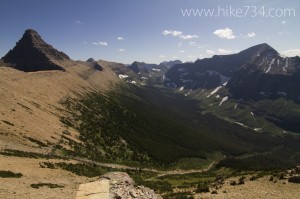Your cart is currently empty!

The hard decision to turn back
—
by

Just recently, we were elated to hear of the rescue of a couple of hikers that spent a few days in the backcountry of Glacier National Park. In the official press release here, the NPS commended them for realizing their predicament and hunkering down to get discovered. A local photographer and outdoor enthusiast Tony Bynum had an insightful piece here on their plight and who the real heroes were. I tend to share his sentiments.
During my Hike 734 project, I encountered many different folks with varying views on risk, particularly with how it sat with wilderness. Some won’t go hiking because of bears at all, while others are sprinting to become a statistic. One such hiker who joined me fell into the latter category.
On one trip towards the end of the season, we had a big day that started and ended in crossing the Middle Fork Flathead River. The day had a lot of miles and, being the fall, less daylight than summer. Throughout the day, I felt like I was pushing every time we stopped that we should hurry up as I didn’t want to get out at dark which really meant that I didn’t want to wade across a river with a headlamp. He didn’t seem to get it, took forever and when it was all said and done, I waded across in the dark while he decided that crossing the river was too dangerous for him and he walked an additional six miles by himself, in the dark to a bridge where I ended up picking him up. (For the record, I take partial blame for starting later in the day than I wanted to. Also, I was already across the river when his decision to hike out was made.)
One of the things that is attractive in wilderness pursuits is that of the unexpected. We happen to come across an animal that we’ve been dying to see, the sun hit flowers in a magical way, etc. There is also an allure to doing something that’s not completely safe which intensifies the experience and stretches us. In conversations that ensued, I basically told him that “being safe” in the wilderness has plenty of risks inherent with the activities and we don’t need to go piling on silly behavior on top of that making things worse than they can be (such as rescues in the night, terrible weather, etc).
In conversations with a search and rescue friend of mine, he says that everyone has an allotment of lucky tokens. The problem is that you don’t know if you have one or a hundred. Often we mistake using up those tokens as competence until we run out. In avalanche classes, one major topic that they talk about is the wisdom of knowing when to “call it” so that you can “ski another day” when the conditions don’t look great. So often with mountain pursuits, we have a feeling that we’ve come a certain distance, want to test ourselves or don’t want to be a “quitter”, so we push on when we should turn around. One of the joys of wilderness pursuits is pushing yourself farther than you thought you could go. The tricky part is knowing where your limits are as well as when the wilderness is just going to smack you down.
It took me a couple of tries to hike the Dawson-Pitamakan loop which is what these guys were trying to do. It’s a fantastic day hike with wonderful views of lakes, drainages and monstrous rugged peaks. Pretty close to where things got really ugly for these guys, I was caught in a rainstorm that literally picked me up and blew me off of the trail. We decided to turn around and head back down. It was the right call and we all made it, but I absolutely hated it. That wasn’t the only time I’ve had to turn around and I’ve hated it every time, but I’ve done it and am glad I did. This doesn’t mean that I’ve probably used up a token or two, but it’s part of a culture of knowing when to call it… even if it hurts.
There will be more instances like this. When they lost the trail and their map, they should have turned back around. Some stories have happy endings and some sad, but hopefully some folks will get the word and foster a culture within their group that knows when to turn back, not because they’re quitting, but because it’s the right thing to do. Ski another day.
How do you decide when it’s time to turn around whether by yourself or in a group?
Comments
10 responses to “The hard decision to turn back”
-
Thanks for this post, it’s definitely something that needs to be talked about more. There are certainly plenty of risks in the outdoors without us piling on. One thing that has helped me overcome my ego is to create objective measurements to guide me like having a specific time when I have to turn around, or a specific pace I have to maintain.
-
Ahhh! Excellent suggestion! I’ve used that with a buddy of mine when we were trying for a peak in an area that we’d never been. Getting that good objective data helps out with the irrational mumbo jumbo. 😉
-
-
Fantastic piece. I’m glad you drew upon your recent, authentic glacier experiences. Thank you for taking the time to put together a meaningful blog post, well said! If you’re ever in east glacier give me a shout. Tony Bynum
-
Thoughtful post, Jake. It’s always tempting to stretch a bit farther than we should. I once spent a long day on Castle Reef on the Rocky Mountain Front where I ran out of water right before reaching the summit. The urge to find more water made me take a different route down than I’d taken up, and not surprisingly it turned into an adventurous “long cut” peppered with downclimbing of cliffs that saw me getting back to the trail well after nightfall. Luckily I had a headlamp in my pack that I hadn’t thought I’d brought, and I made it out safe. But I probably should’ve turned around when it became obvious I wouldn’t have enough H2O for the whole trip. I’ve sort of come to the realization that any day outdoors is time well spent whether you reach your stated objective or not. I finally bagged Mount Clements in Glacier this year after several attempts over nearly two decades, and it was well worth the wait. When in doubt, turn an expedition into a sight-seeing stroll, and live to hike another day.
-
Well said Eric!
-
-
Ultimately these conversation all come round to “Managed Risk”. The trouble with hiking versus rock climbing/parajumping/etc. is the risks are not as poignant. The are just as real though.
Bynum was right, they pushed when they should have pulled. There is nothing heroic about endurance brought on by desperation due to negligence.
-
@jeremiah, yes it is all about managing risk, but also, hiking glacier is far from the junkies that participate in extreme sports. . . To me, that’s a different matter – those people are on a different level . . . I have a ton of respect for guys and gals that do harrowing and “crazy” extreme sports, but at the end of the day, the very best any extreme sports person can do is hope to manage the things they can control, the rest is out of their hands . . . That said, the results in either case – hiker vs extremest, could be similar – not coming home alive . . . Thanks for the comments! Tony Bynum
-
-
Great analysis, Jake. This should be required reading for all backcountry hikers. The moral is that even the best have to turn around so that they can hike another day.
-
Thanks for the article Jake. As a person with arthritis and bursitis, hiking is both an outlet for my soul and exercise for my body. But, I know if I push my body too far that I will regret it (days and days of pain). Life is all about balance.
-
[…] just south of Glacier National Park is a beast of a mountain. Kristen and I tried summiting it a few weeks ago, but the weather was terrible and we wanted to do it when we could enjoy the […]


Leave a Reply